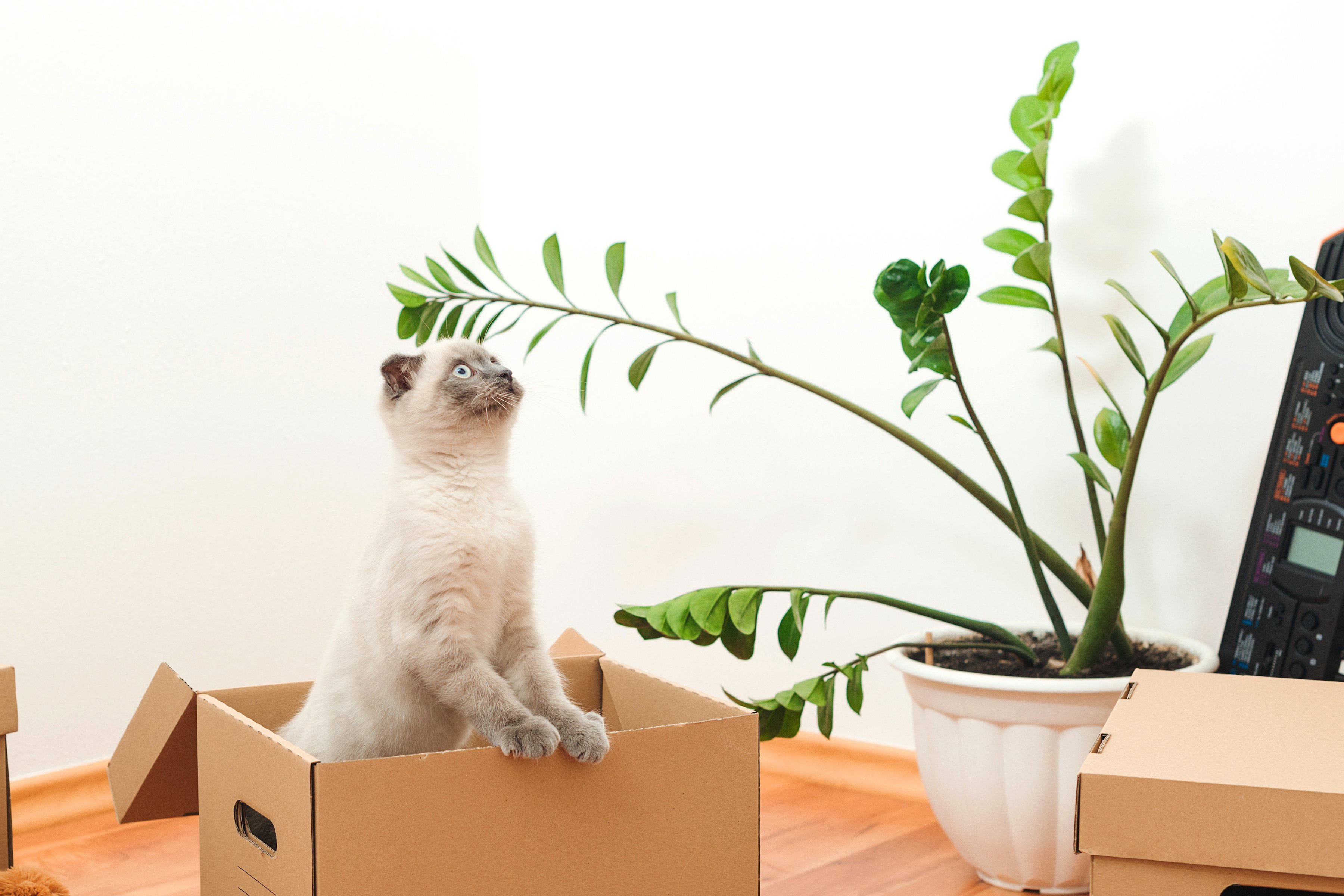The Ultimate Guide to Moving With a Pet
Your family pet is a cherished part of your household. That’s why it’s so important to make your pets feel just as comfortable – from head down to paws, or claws – as you and the kids during the stress of a home move.
More American families own pets, up to 67% of households, or 85 million families, according to a 2020 National Pet Owners Survey by the American Pet Products Association. That’s up from 56% in 1988, the first year of the survey. To put these stats into perspective, more households have fur babies than human babies (52.8 million), with dogs ranked first.
When it’s time to prep for a long-distance move from your home, keep in mind how to best introduce your faithful friend to a new environment. It’s just as stressful for your four-footed family members to have their daily routines and smells change. Do so with the most comfort and the least amount of challenges. Here are some of our tips to do before, during, and after to minimize moving anxiety for your pet. 
Research the Home’s Location
Representing 35% of pet owners, millennials are serious about the care of their pets. They regularly pamper them with gifts and treats and consider their needs when looking at where to move. It’s why more new construction communities and condo complexes are including dog parks as a feature. We should all take cues from this generation when searching for where to relocate. Account for the property’s or nearby amenities that will make you all more comfortable.
Start with a reputable home or apartment-buying website for your research that is searchable for amenities in cities and neighborhoods that will be best for you and your best friend. Among these could be the home’s backyard size and whether or not it’s fenced in, the neighborhood’s walkability, and the home’s proximity to local vets/animal hospitals, dog parks, and pet-friendly restaurants and businesses.
Check Local Laws and Regulations
Check into laws and regulations concerning pets on the state and local level, so you and your loved ones of all species are in the know. Here’s what to check:
State Laws
- State pet laws vary regarding the registration and ownership of dogs, cats, horses, parrots, tropical fish, and other pets. For example, you can have a pet skunk in Florida but not in Maryland.
- The type of border inspection required for animals being imported, i.e., random inspections by the state’s department of agriculture, checking interstate health certificates, or a combination.
Local Laws
- Pet control and licensing ordinances that limit the number of dogs or cats in each household.
- If you have horses, ponies, or other livestock, get to know the stabling regulations and whether or not the stable is allowed within city limits.
- Some local ordinances restrict specific pets, such as owning poultry or animals like rabbits or pigs.
- License fees and how long you have to obtain one after moving.
Compile & Update All of Your Pet’s Info
Another pre-move step is to schedule a visit with your vet to get a health checkup and any required documentation, vaccinations, or medications they’ll need before moving day. This is a good time to discuss any concerns you have for your pet’s safety and anxiety during travel. If you have a long travel time or a highly anxious pet, it may be wise to get a prescription for motion sickness or anxiety that you can give during travel.
Here are a few documents to leave the vet office with:
- Health certificate: Nearly all states require interstate health certificates for dogs and horses. Some enforce the same for cats, birds and other pets. Some require advance receipt of the certificate before entry. Health certificates must have: complete description of the pet, a list of inoculations, and a statement that your pet is free from infectious diseases.
- Permit: You may have a pet that must be accompanied by a permit, per the state’s regulatory agency, which either you or your vet can apply for it. Some states may require advance receipt of your pet’s health certificate beforehand.
- Rabies Tag: With the exception of four, most states require dogs to have rabies vaccinations. Some have the same regulation for cats. The rabies tag should be securely attached to your pet’s collar.
- Travel ID Tags: Your pet should be identified with a tag that lists the pet’s name, your name, your destination address, and the name and address of an emergency contact person. If your pet is microchipped, you still need an ID tag on the collar. The health certificate can also be used for identification; birds can use leg band IDs, and horses and ponies by brands, tattoos, color photos or registration papers.
Choose Your Transportation Method
You’ll have to decide the transportation method that’s best for you and their comfort. Sometimes the distance from point A to B may trump your personal preference. A few notes on the different ways to make your move:
- By Motor Vehicle: If your move is a day’s drive time travel or less, this is the most practical way to transport your pet. It’s still a viable option if you do need to stay overnight. You’ll just need to make sure your route has pet-friendly lodging available and reserve ahead of time. For dogs and cats, it’s a good idea to keep them in a cat carrier or portable dog crate for an overnight or multi-day road trip. Train your dog or cat on a leash or harness so they’re well-behaved on potty breaks at rest stops. Dogs and cats should be taught to sit or lie quietly in one place; a safety harness helps. For safety, don’t let your dog hang its head out of the window. For larger animals, like horses and livestock, you’ll want to plan ahead more for stops that can accommodate your hauling trailer and to check-in with your pet.
- Accompanied Pets By Air Travel: If pets are small enough to fit in a carrier that will slide under your seat, some airlines will allow them in passenger cabins. Larger pets will have to travel unaccompanied as air freight, which we’ll go over next. Make reservations for your pet passenger far in advance, as the number of pets permitted on a flight is limited. Harnessed seeing-eye dogs travel free and lie at their owner’s feet, but the airline must still be notified in advance.
- Unaccompanied Pets by Air Travel: Shipping reservations will need to be made way ahead of time because of limited space; dogs and cats will travel by air freight, while birds, tropical fish, hamsters, and gerbils will be transported by air express, an air freight division. It’s recommended to use the airline’s travel kennels. These should be labeled with your name, address, and phone number. Arrive in plenty of time at the air freight terminal. To have your pet fly in moderate weather, book either early morning or late evening flights.
Create a Pet Travel Kit & Checklist
You can never be too overprepared. We’ve gathered a list of what to pack for your pet’s travel kit. Use this as a checklist of what to remember before takeoff or before you get behind the wheel.
We recommend the animal travel kit includes:
- Supply of food and water for the days of travel (can opener if needed for wet food).
- Don’t feed or water your pet right before you depart in case they are motion sick
- Spill-proof food and water dishes
- Favorite blanket/pillow
- Treats and toys
- Towels or paper towels for cleanup of any potential messes
- Poo bags
- Stake and leash
- A sedative, if prescribed by your vet
- Cage or carrier
A checklist of things to ask yourself before you head out in the car or before liftoff:
- Do you have your pet’s travel ID, health certificate, vet record, and rabies tags on his collar on hand?
- Did you have your dog’s nails clipped to prevent damage to your car’s interior?
- Have all transit transportation charges been paid if traveling by air?
- Are all health and shipping documents in order if flying or shipping your pet?
- Is the shipping container in good shape and correctly labeled?
Keep Your Pet Out of the Action on Move Day
We can’t say enough how stressful a move could be for your pet, just like it is for you. They know when something big is happening! There are ways to curb their stress level and control their anxiety while you pack up their comfort zone.
We recommend that you leave your best friend with a trusted friend or kennel for moving day. If you can’t make that happen, at least keep them in the quietest area or room possible in the house. A fenced-in backyard is a good alternative option, weather permitting. Check on them regularly, feed, water, and walk them like your regular routine as much as possible.

Help Them Settle Into Your New Home
Tip: Move the house before you move the pet. Set up as much as you can, even if it’s just one room, before your pet’s first introduction. Include familiar toys, blankets, and furniture surroundings.
Before your pet sniffs and wanders around the house, make sure you pet-proof inside and outdoors, looking for any hazards, holes in the ground, or possible ways to escape the backyard and run away. Then, when it’s safe, gradually open the door to other areas of the house. Let them explore and smell the new and familiar smells so they realize that this is their new home. If you have a new backyard, consider walking them around on their leash first.
Place food and water dishes in the same sort of location they were in the old home. Stick to the same feeding schedule and any other routines to re-establish normal as soon as possible.
Moving Tips For Pets By Type
Again, all species of our beloved pets come with their own set of unique needs on moving day. Here’s a quick recap of moving tips for each type of pet:
- Moving with a Dog: Establish a routine, keep the dog comfortable, keep the dog moving with exercise, and give the dog lots of love.
- Moving with a Cat: Make sure your kitty is comfortable in her carrier, let them play with boxes while you pack, deep-clean your new home to take away any unfamiliar scents, and make their food and litter box easy to find. Cats can be highly anxious, so consider helpful travel medicine.
- Moving with a Bird: It’s best to put them in a cage on the move. Bring lots of cage lining, water, and feed.
- Moving with a Fish: For short-distance moves, you can transport fish in bags that are filled with their old tank water. Alternatively, a minnow bucket topped by a lid with air holes makes a good carrier. For long distances, it’s best to let a friend adopt them, empty and clean the tank, and buy new fish for your new home.
- Moving with a small caged animal: Gerbils, hamsters, guinea pigs, rabbits, and more can travel in their cage from home; remove the water dish to avoid spills, but give them fresh water at each stop to avoid dehydration. For reptiles, keep an eye on the cage temperature and internal car temperature.
- Moving with Horses or Ponies: Transport your horse or pony commercially via air freight or tow them in a horse trailer behind your vehicle. Rental trailers are available.
Updated May 2024





